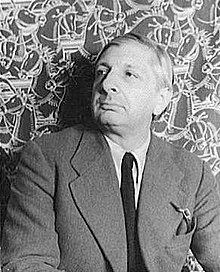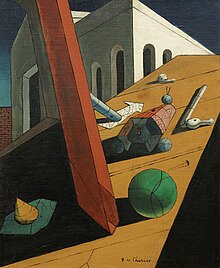Giorgio de Chirico
Jump to navigation
Jump to search
Giorgio de Chirico (Italian: [ˈdʒordʒo deˈkiːriko]; 10 July 1888 – 20 November 1978) was an Italian artist and writer. In the years before World War I, he founded the scuola metafisica art movement, which profoundly influenced the surrealists. After 1919, he became interested in traditional painting techniques, and worked in a neoclassical or neo-Baroque style, while frequently revisiting the metaphysical themes of his earlier work.
| Giorgio de Chirico | |
|---|---|

In 1936, photographed by Carl Van Vechten
| |
| Born | Giorgio de Chirico July 10, 1888 Volos, Greece |
| Died | November 20, 1978 (aged 90) Rome, Italy |
| Nationality | Italian |
| Education | Athens School of Fine Arts, Academy of Fine Arts in Munich |
| Known for | Painting, sculpture, drawing, costume and stage design |
| Notable work | see Selected works |
| Movement | Metaphysical art, surrealism |
Contents
Life and works
The Song of Love, 1914, oil on canvas, 73 × 59.1 cm, Museum of Modern Art, New York
He returned to Italy in the summer of 1909 and spent six months in Milan. At the beginning of 1910, he moved to Florence where he painted the first of his 'Metaphysical Town Square' series, The Enigma of an Autumn Afternoon, after the revelation he felt in Piazza Santa Croce. He also painted The Enigma of the Oracle while in Florence. In July 1911 he spent a few days in Turin on his way to Paris. De Chirico was profoundly moved by what he called the 'metaphysical aspect' of Turin, especially the architecture of its archways and piazzas. De Chirico moved to Paris in July 1911, where he joined his brother Andrea. Through his brother he met Pierre Laprade, a member of the jury at the Salon d'Automne, where he exhibited three of his works: Enigma of the Oracle, Enigma of an Afternoon and Self-Portrait. During 1913 he exhibited paintings at the Salon des Indépendants and Salon d’Automne; his work was noticed by Pablo Picasso and Guillaume Apollinaire, and he sold his first painting, The Red Tower. In 1914, through Apollinaire, he met the art dealer Paul Guillaume, with whom he signed a contract for his artistic output.
Le mauvais génie d'un roi (The Evil Genius of a King), 1914–15, oil on canvas, 61 × 50.2 cm, Museum of Modern Art, New York
The Seer, 1914–15, oil on canvas, 89.6 × 70.1 cm, Museum of Modern Art, New York
Great Metaphysical Interior, 1917, oil on canvas, 95.9 × 70.5 cm, Museum of Modern Art, New York
De Chirico is best known for the paintings he produced between 1909 and 1919, his metaphysical period, which are characterized by haunted, brooding moods evoked by their images. At the start of this period, his subjects were still cityscapes inspired by the bright daylight of Mediterranean cities, but gradually he turned his attention to studies of cluttered storerooms, sometimes inhabited by mannequin-like hybrid figures.
In autumn, 1919, de Chirico published an article in Valori plastici entitled "The Return of Craftsmanship", in which he advocated a return to traditional methods and iconography.[3] This article heralded an abrupt change in his artistic orientation, as he adopted a classicizing manner inspired by such old masters as Raphael and Signorelli, and became an outspoken opponent of modern art.[4]
In the early 1920s, the Surrealist writer André Breton discovered one of de Chirico's metaphysical paintings on display in Guillaume's Paris gallery, and was enthralled.[5] Numerous young artists who were similarly affected by de Chirico's imagery became the core of the Paris Surrealist group centered around Breton. In 1924 de Chirico visited Paris and was accepted into the group, although the surrealists were severely critical of his post-metaphysical work.[6]
De Chirico met and married his first wife, the Russian ballerina Raissa Gurievich in 1925, and together they moved to Paris.[7] His relationship with the Surrealists grew increasingly contentious, as they publicly disparaged his new work; by 1926 he had come to regard them as "cretinous and hostile".[8] They soon parted ways in acrimony. In 1928 he held his first exhibition in New York City and shortly afterwards, London. He wrote essays on art and other subjects, and in 1929 published a novel entitled Hebdomeros, the Metaphysician. Also in 1929, he made stage designs for Sergei Diaghilev.[2]
De Chirico in 1970, photographed by Paolo Monti. Fondo Paolo Monti, BEIC
In 1939, he adopted a neo-Baroque style influenced by Rubens.[7] De Chirico's later paintings never received the same critical praise as did those from his metaphysical period. He resented this, as he thought his later work was better and more mature. He nevertheless produced backdated "self-forgeries" both to profit from his earlier success, and as an act of revenge—retribution for the critical preference for his early work.[9] He also denounced many paintings attributed to him in public and private collections as forgeries.[10] In 1945, he published his memoirs.[2]
He remained extremely prolific even as he approached his 90th year.[11] During the 1960s, Massimiliano Fuksas worked in his atelier. In 1974 de Chirico was elected to the French Académie des Beaux-Arts. He died in Rome on 20 November 1978.
His brother, Andrea de Chirico, who became famous under the name Alberto Savinio, was also a writer and a painter..





Comments
Post a Comment